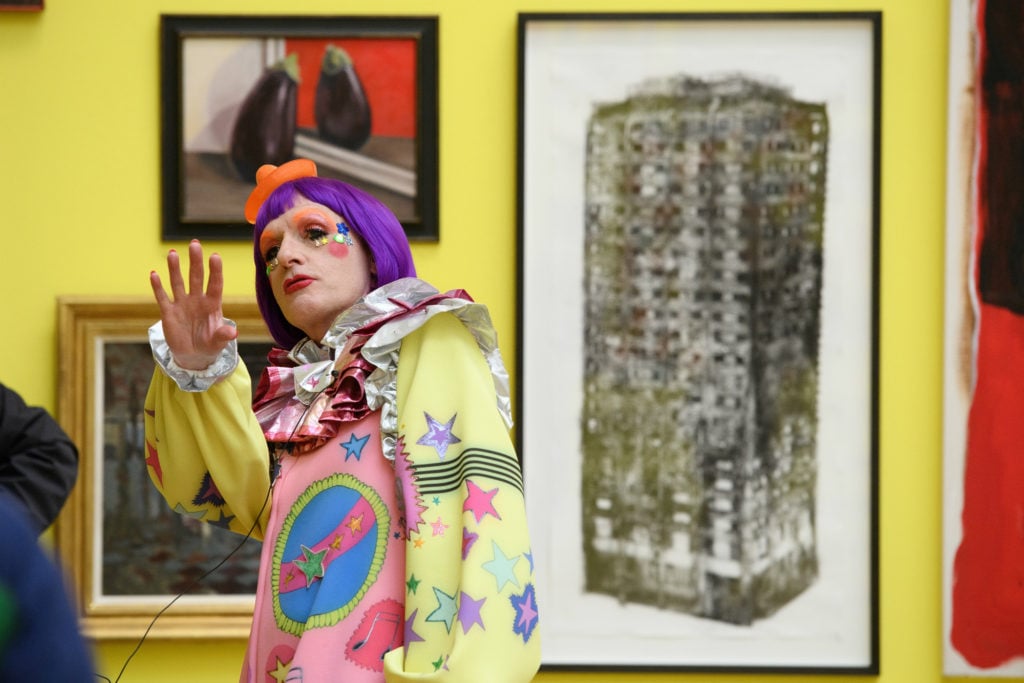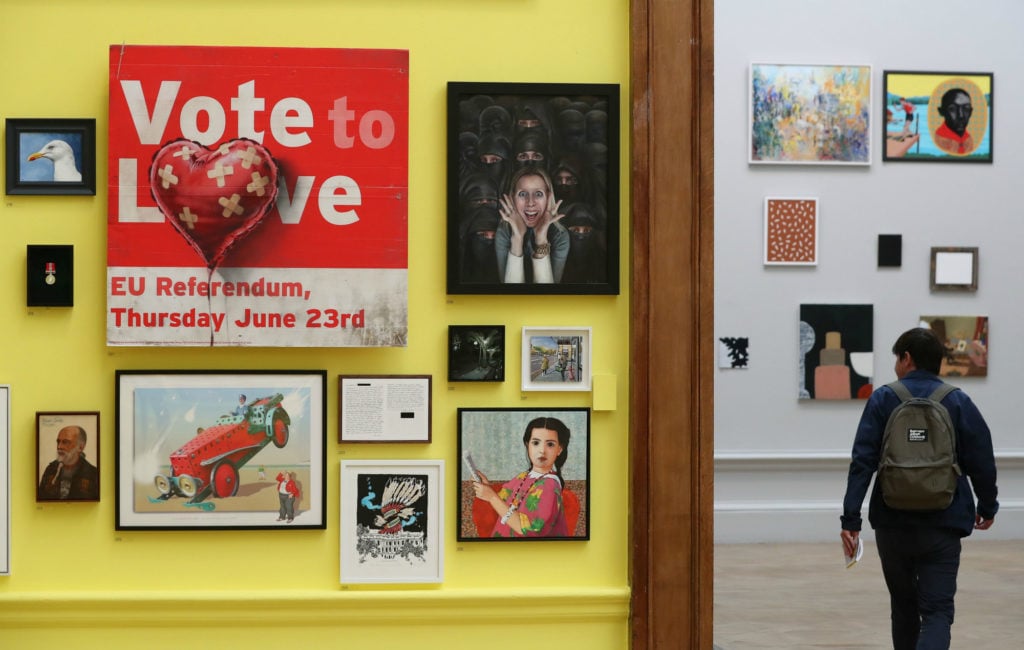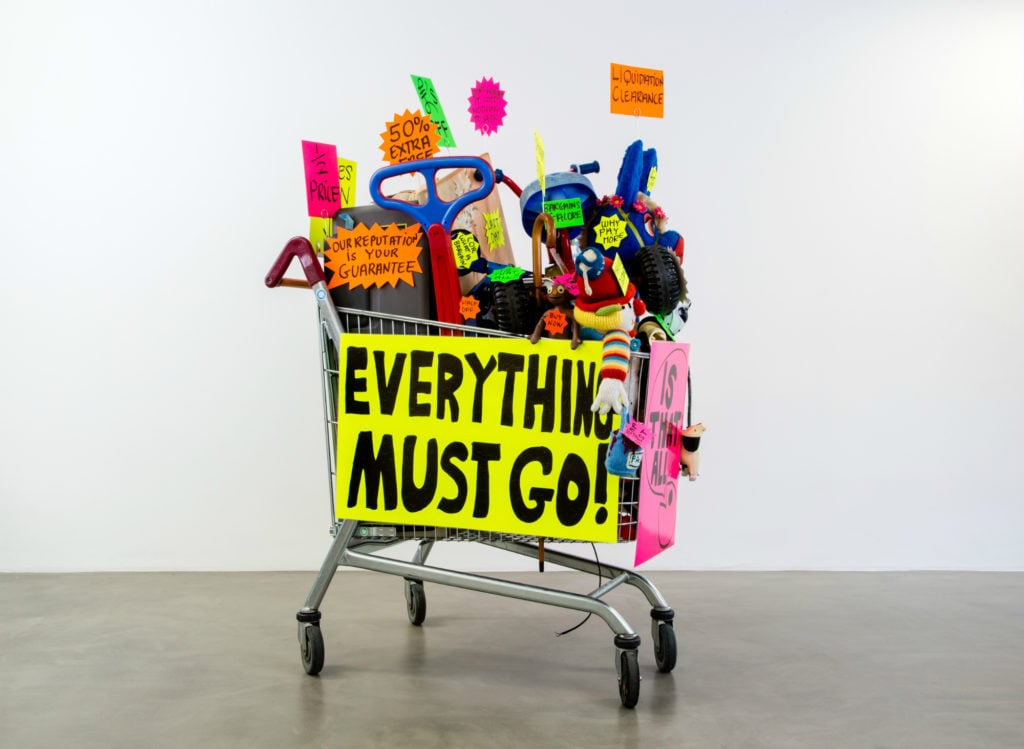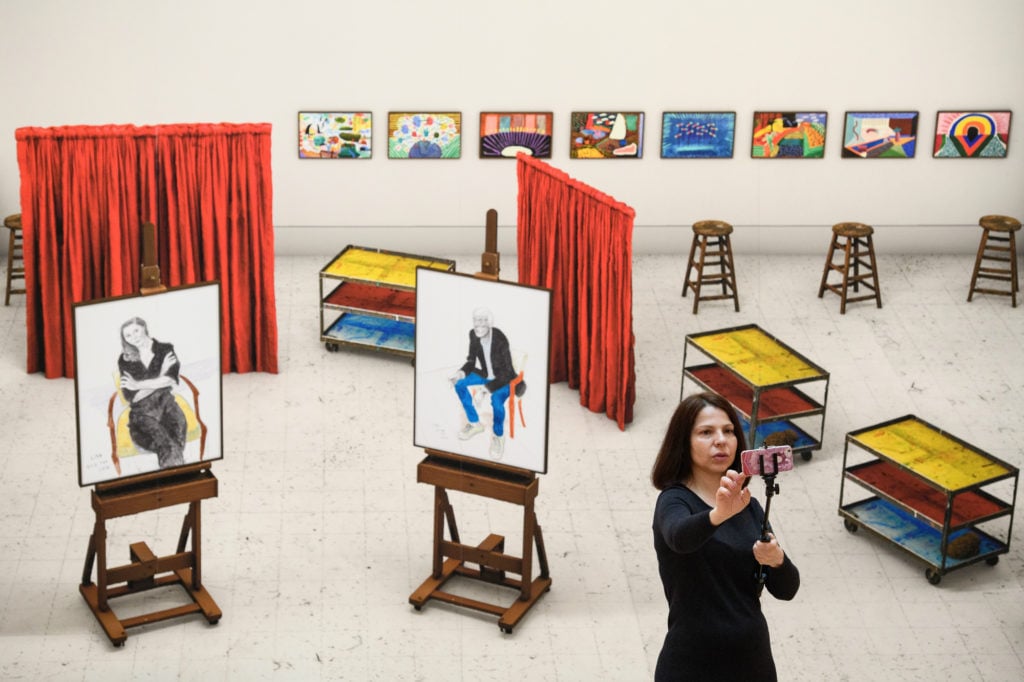Art & Exhibitions
Banksy Is Selling a $466 Million Statement About Brexit at the Royal Academy’s Topical Summer Exhibition
Academician Grayson Perry earns a rave review for filling London's annual ritual “with crap” in its 250th year.

Academician Grayson Perry earns a rave review for filling London's annual ritual “with crap” in its 250th year.

Javier Pes

The Royal Academy of Arts’s annual “Summer Exhibition” has always been a mixed bag of art by the great, the good, and the unknown. The 250th edition of the show, co-organized by academy member Grayson Perry, is madder and more colorful than ever. Dressed as his alter-ego Claire, Perry held court at the press preview on Tuesday.
For probably the first time in living memory, a leading art critic has given the show a five-star review. The Guardian’s Jonathan Jones writes that Perry has “filled it with crap”—in a good way. “This is the most liberating exhibition of new art I’ve seen for ages, because it obliterates definitions of what’s good or bad, archaic or modern, and invites us to sample all the ways people can use a thing called ‘art’ to express feelings and ideas,” the critic opines. The academy is more used to critical brickbats than bouquets for its annual open exhibition, the most popular and remunerative show it organizes.

Banksy’s Vote to Love in the “Summer Exhibition” at the Royal Academy of Arts. Photo by Daniel Leal-Olivas/AFP/Getty Images.
This year’s exhibition is more topical—and colorful—than ever, thanks to Perry. The choice of wall paint includes lemon yellow and turquoise. Banksy’s bright red submission, a statement about Brexit, is symbolically priced at £350 million ($466 million). The price reflects the amount that the Leave campaign once promised would go to the UK National Health Service each week if Britain left the EU. The artist has spray-painted on a scruffy pro-Leave placard so that it reads “Vote to Love,” confirming his status as the unofficial artist for so-called “Remoaners.”
Perry and his fellow academicians on the exhibition selection committee—who include Phyllida Barlow, Cornelia Parker, Conrad Shawcross, and David Mach—have picked works submitted by fellow members of the academy, several illustrious honorary academicians, and thousands of hopeful artists who only dreamed of hanging their works alongside the likes of Anselm Kiefer, Marina Abramović, El Anatsui, and Ed Ruscha. (The US artist is in London for the opening of his show at the National Gallery this week.)

Michael Landy, Closing Down Sale, image copyright the artist, courtesy of Thomas Dane Gallery.
Among the cheerful—if not cheaper—works on sale is Michael Landy’s shopping trolley. Piled high with goods and handmade signs and audio recordings, it announces bargain prices and that “Everything Must Go.” Called Closing Down Sale and priced at £42,000 ($56,000), the sculpture sets the tone for the selling show and provides the cover image for the exhibition catalogue, which lists the 1,200 or so works that are piled high in the galleries.
This year the exhibition spills into the academy’s Sackler Galleries upstairs, which are filled with mainly prints and photographs, including one by new academicians, Jane and Louise Wilson. Their prints of a derelict H-bomb test facility in the east of England are on offer for 26,000 ($35,000), in an edition of four. The move is a gamble for the RA, as it relies on healthy sales of works, in particular the multiples, indicated by a rash of red dots, to fund its students. Most of the academy’s 30 percent commission goes to supporting the RA Schools, a program that provides free tuition to 51 postgraduate students.
Several pieces in the show reference the UK’s housing crisis and at least two commemorate the fatal fire that destroyed Grenfell Tower in west London a year ago. On the grand staircase, Mike Nelson has filled a decrepit sleeping bag with builders’ rubble to create a brutalist piece, Untitled (Public Sculpture for a Redundant Space), which is not for sale. Other topical works include more than one depicting the North Korean leader Kim Jong-un, while Alison Jackson has created Trump and Miss Mexico, an edition of five at £9,000 ($12,000), with the help of her cast of lookalikes.
Among the monumental works is an enormous textile column by Joana Vasconcelos, Royal Valkyrie, which dominates the Central Hall, while Anish Kapoor’s giant red circle towering above a pile of boulders fills the courtyard. Neither are for sale.

David Hockney’s Seven Trollies, Six and a Half Stools, Six Portraits, Eleven Paintings, and Two Curtains (detail) at the “Summer Exhibition.” Photo by Leon Neal/Getty Images.
A companion exhibition puts the annual salon into its historical perspective. Co-curated by Mark Hallett, the director of studies at the Paul Mellon Centre for Studies in British Art along with Sarah Victoria Turner, the center’s deputy director of research, “The Great Spectacle: 250 Years of the Summer Exhibition,” which is accompanied by a book published by Yale University Press, includes some of the show-stopping works from past exhibitions. Such was the crush to see David Wilkie’s historical painting of old soldiers reading of Napoleon’s defeat, Chelsea Pensioners Reading the Waterloo Despatch (1822) that the academy had to put a barrier around the painting “to prevent admirers from touching it.”
Hallett described how in the 19th-century academicians, which included JMW Turner, would work all winter on the works they were submitting for the “Summer Exhibition.” David Hockney is keeping that tradition alive. He is showing two huge new panoramas featuring the artist, his works, and friends in a studio setting. They measure around seven meters (about 23 feet) in length and neither is for sale. One of them, with a typically Hockneyesque title Seven Trollies, Six and a Half Stools, Six Portraits, Eleven Paintings and Two Curtains, includes a depiction of a portrait on its easel, which the artist completed on Christmas Eve. Dated December 23–24, 2017, it is proof that the LA-based artist, who like Ruscha has just turned 80, is still going strong, just like the “Summer Exhibition.”
The Royal Academy of Arts’s “Summer Exhibition 2018” runs from June 12 through August 19.